 
Click the items below to open a small extra window with
more about
|
 |
|

|

 25 October - 6 November 1987 25 October - 6 November 1987
Past glory - busy present
Canton and Xiamen
|
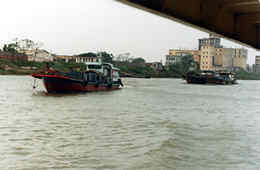 Yangshuo to Canton by boat
Yangshuo to Canton by boat
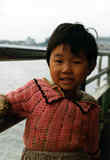 Early
in the morning after the usual pancake-breakfast we leave on an
unusual (for us, while in Yangshuo) sunny day by long-distance bus
to he city of Wuzhou. It is a nice ride through the sunny Chinese
countryside. We see a wedding (at least we see people walking with
furniture on the roadside but that probably is part of a wedding-ceremony).
When it gets dark we arrive in Wuzhou. A couple of students from
a tourism educational intitute take us from the bus to the boat
(at the other side of the road), Early
in the morning after the usual pancake-breakfast we leave on an
unusual (for us, while in Yangshuo) sunny day by long-distance bus
to he city of Wuzhou. It is a nice ride through the sunny Chinese
countryside. We see a wedding (at least we see people walking with
furniture on the roadside but that probably is part of a wedding-ceremony).
When it gets dark we arrive in Wuzhou. A couple of students from
a tourism educational intitute take us from the bus to the boat
(at the other side of the road),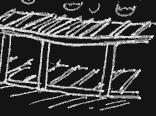 meanwhile enthusiastically practicizing English at us. We slep at
the boat, that takes us along the Xi Jiang (=West river) to Canton
brengt. The boat has a basic kind of sleeping-arrangement, people
lay side-by-sidelike sardines in a tin (well not quite so close).
There are sleeping places at two levels: ground-level and at about
one-and-a-half meter above ground level. They are made from wood
and people are separated by small (not much higher then a few inch)
partitions. We lay with our heads to the outside wall (we're lucky
to have beds on the upper level so we are near a port-hole) and
your feet to the mid-ship. (The drawing at the right might make
it clearer). This way in quite a small boat quite a lot of Chinese
can go to Canton. And some foreigners like us.
meanwhile enthusiastically practicizing English at us. We slep at
the boat, that takes us along the Xi Jiang (=West river) to Canton
brengt. The boat has a basic kind of sleeping-arrangement, people
lay side-by-sidelike sardines in a tin (well not quite so close).
There are sleeping places at two levels: ground-level and at about
one-and-a-half meter above ground level. They are made from wood
and people are separated by small (not much higher then a few inch)
partitions. We lay with our heads to the outside wall (we're lucky
to have beds on the upper level so we are near a port-hole) and
your feet to the mid-ship. (The drawing at the right might make
it clearer). This way in quite a small boat quite a lot of Chinese
can go to Canton. And some foreigners like us.
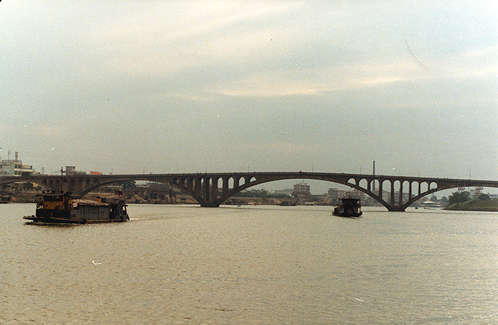 Photo:
along the Xi river fromWuzhou to Canton (Guangzhou). Photo:
along the Xi river fromWuzhou to Canton (Guangzhou).
|
Canton
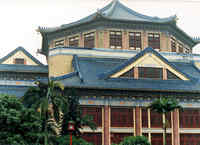 In
Canton the next morning we take a taxi to the Youth hostel on Shamian
Island. There is no double room available but we can sleep in the
dormitory. Maybe three will be a double room tomorrow. If we ask
for it the next day something happens that was an extraordinary
example of the behavior of Chinese working in tourism (in a state
owned hotel) in the late 80''s: we are told it is not possible to
have a double room, and it will not be possible for the next few
weeks. The hotel is full of foreign students that have taken up
all the doubles and that will remain so for quite a while. So we
beter forget about having a double room. In
Canton the next morning we take a taxi to the Youth hostel on Shamian
Island. There is no double room available but we can sleep in the
dormitory. Maybe three will be a double room tomorrow. If we ask
for it the next day something happens that was an extraordinary
example of the behavior of Chinese working in tourism (in a state
owned hotel) in the late 80''s: we are told it is not possible to
have a double room, and it will not be possible for the next few
weeks. The hotel is full of foreign students that have taken up
all the doubles and that will remain so for quite a while. So we
beter forget about having a double room.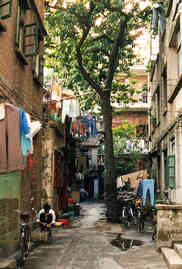 .
We are a bit disappointed but not so very much, we stay talking
together near the counter when all of a sudden the receptionist
throws a key on he counter, in our direction,: "Room number
18". So a double room after all, and obviously it was there
all along. The last time I was in China the attitude was very much
improved, but in 1987 the Chinese working in a (state)hotel got
paid anyway, customers or no customers, so a lot of them chose the
way of the least work. .
We are a bit disappointed but not so very much, we stay talking
together near the counter when all of a sudden the receptionist
throws a key on he counter, in our direction,: "Room number
18". So a double room after all, and obviously it was there
all along. The last time I was in China the attitude was very much
improved, but in 1987 the Chinese working in a (state)hotel got
paid anyway, customers or no customers, so a lot of them chose the
way of the least work.
In Canton we really start to get used to the rythm of travelling:
at arrival we look for a place to sleep, next we arrange transport
to our next destination a few days later, we walk around a lot,
see the most interesting sights, look for places to eat, shops for
handkerchiefs or toothpaste or batteries or whatever, wash our clothes,
read books, write letters and leave. Arranging the journey to the
next destination invariably takes a lot of time in China, one of
he main reasons is the struggle of communication: they don't speak
English, we don't speak Chinese. Because of previous bad experiences
we decide to spend some money and take the plane to Xiamen (Amoy)
our next destination (and the last in China). After some running
about we succeed. We think we have bought tickets for the flight
of monday the third of november to Xiamen.........
|
|

Our hotel is situated on Shamian Island, which is connected by
a couple of bridges to the rest of the city. In the days that Canton
was an important trading city of the English and other Europeans
Shamian used to be the place where the Europeans had their homes
and their warehouses. Actually, in the 18th century Europeans where
not allowed anywhere else but Shamian (and only from september to
march). At the end of the 19th century the island was forbidden
for Chinese and dogs after sundown..... The great houses still are
there, but apart from some saved as offices, most of it is past
glory. They are inhabited by many families, one to a room and washing
hangs drying from all the windows. (see extra photo's of the houses
on Shamian  )Opposite our hotel there is a very luxurious and expensive hotel,
the White Swan. I cannot suppress my craving for western food (I
am not much of a traveller really) and persuade my friend to go
threre to have a drink together and (I at least) eat a hamburger.
There is a small crowd at the terrace in front of the hotel. Somebody
sees us and before we know what is going on, we are pulled from
the crowd and put at a table It appears to be the film-set of a
rather romantic (judging from the scene I saw) Chinese film and
we pale-faces are doing fine as background. However, at the reviewing
of the scene we are mostly hidden behind the back of one of the
main characters. Well, at least we got a part in a Chinese movie.
We go into the hotel, admire the water-fall in the inner court, (where
Chinese love to have taken their photographs) and go for a drink.
)Opposite our hotel there is a very luxurious and expensive hotel,
the White Swan. I cannot suppress my craving for western food (I
am not much of a traveller really) and persuade my friend to go
threre to have a drink together and (I at least) eat a hamburger.
There is a small crowd at the terrace in front of the hotel. Somebody
sees us and before we know what is going on, we are pulled from
the crowd and put at a table It appears to be the film-set of a
rather romantic (judging from the scene I saw) Chinese film and
we pale-faces are doing fine as background. However, at the reviewing
of the scene we are mostly hidden behind the back of one of the
main characters. Well, at least we got a part in a Chinese movie.
We go into the hotel, admire the water-fall in the inner court, (where
Chinese love to have taken their photographs) and go for a drink.
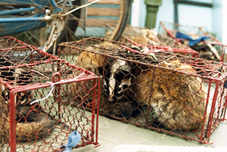 There's
a saying that says Chinese eat all that has four legs (except for
tables) and the QingPing market in Canton is known as the place
where you can find it. For European animal-lovers it's one big sad
affair,while for Chinese animal-lovers (in another sense of the
word) it's a huge feast: claws of bears, puppy-dogs, frogs, rare
fish, snakes, monkeys, tigerskins...........anything you can think
of you can get to eat or to use as medicine. The next day, at washing
my jeans I have a hard time and need a lot of Sunlight soap to remove
most of what turn out to be blood-splatters from the Qingping market.
In Canton we also went to see the zoo. This was, if possible, even
more sad then the market. The animals where visibly feeling miserable
in their too small cages while the visitors where amusing themselves
by throwing sticks and pebbles at them.. There's
a saying that says Chinese eat all that has four legs (except for
tables) and the QingPing market in Canton is known as the place
where you can find it. For European animal-lovers it's one big sad
affair,while for Chinese animal-lovers (in another sense of the
word) it's a huge feast: claws of bears, puppy-dogs, frogs, rare
fish, snakes, monkeys, tigerskins...........anything you can think
of you can get to eat or to use as medicine. The next day, at washing
my jeans I have a hard time and need a lot of Sunlight soap to remove
most of what turn out to be blood-splatters from the Qingping market.
In Canton we also went to see the zoo. This was, if possible, even
more sad then the market. The animals where visibly feeling miserable
in their too small cages while the visitors where amusing themselves
by throwing sticks and pebbles at them..
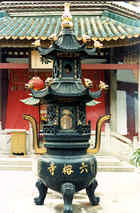 The
Temple of the Six Banyan Trees is one of the nicer things to see
in Canton. There has been a temple on the site where it is located
ever since the 6th century. The buildings where burnt down in the
10th century and rebuilt later. The six banyan trees after which
the temple was named in the 12th century are no longer there, but
the temple is still in use as a buddhist temple. The 55 meter high
Flower Pagoda is the oldest in town. And ever since Bodhidarma,
founder of the Zen sect spent a night in the Pagoda it is rid of
mosquito's.(information Lonely Planet) The
Temple of the Six Banyan Trees is one of the nicer things to see
in Canton. There has been a temple on the site where it is located
ever since the 6th century. The buildings where burnt down in the
10th century and rebuilt later. The six banyan trees after which
the temple was named in the 12th century are no longer there, but
the temple is still in use as a buddhist temple. The 55 meter high
Flower Pagoda is the oldest in town. And ever since Bodhidarma,
founder of the Zen sect spent a night in the Pagoda it is rid of
mosquito's.(information Lonely Planet)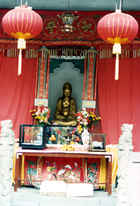
We left at what we thought was monday the 3rd of november to hte
Canton airport for a flight to Xiamen. After waiting for some hours
the flight was still not entered at the check-in counter chalkboard.
So we tried to find somebody who knew and could tell us in English
what was going on. It turned out we where totally wrong about the
date: our flight was on tuesday the 3rd of november, the
next day! So one more night in Canton, it was quite late by then
and to save ourselves from more hotel-trouble (Canton was noted
for problems to get cheap hotel rooms at the time) we went to a
somewhat more expensive hotel near the airport. And tuesday, 3rd
of november we did take the plane to Xiamen.
|
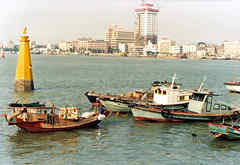 Xiamen Xiamen
Xiamen used be famous, or rather notorious, as a city of pirates.
The name of this Chinese coastal town in Fulian province, South-East
China used to be Amoy in those days. In the 17th century, while
the Manchus marched south, the Ming-dynasty court took refuge in
the trading town. From here it was that the legendary pirate-general
Koxinga, leader of the Ming armies, tried to fight his way back
north. In the end it resulted to retreating to the nearby island
of Taiwan, that was held by the Dutch and besieged for 6 months
before capturing it.
Much later Amoy became an important tradingpost for Europeans and
Americans. The small island of Gulangyu, near the coast, was used
as a residency, it even got the status of "Internatinal Foreign
Settlement" in 1903. For the Dutch Amoy was the place from
where Chinese workers where shipped to the East-Indies. In 1980
Xiamen was opened to tourists, in '81 it became a Special Economic
Zone, what means it has more economical freedom and possibilities
for foreign trade. This year (2001) it was Xiamen from where the
first boat of Chinese to Taiwan left.
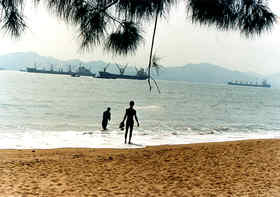 What
I myself
remember best is the hotel where we slept. It was built in the colonial
days with huge rooms, beautifully tiled and a very romantic atmosphere
but quite dilapidated. (It is to keep memories like this that I
made this website, but the memories are only in my head of course,
I cannot really take you there) What
I myself
remember best is the hotel where we slept. It was built in the colonial
days with huge rooms, beautifully tiled and a very romantic atmosphere
but quite dilapidated. (It is to keep memories like this that I
made this website, but the memories are only in my head of course,
I cannot really take you there)
We were not very long in Xiamen.Of course we spent a day on Gulangyu,
a peaceful little island on which cars are not allowed. At the Eastern
beaches you can see Taiwan far away behind the big warships (see
photo). Three days later, on a friday, we left by night boat
(an old Scandinavian ferryboat) to Hong Kong, which was still a
British Crown Colony in 1987. At leaving Xiamen we stopped to eat
in a restaurant near the harbour. When we sat down we were surprised
by Western music: to please us they had put on a tape of christmas
songs! A nice way to depart from China.
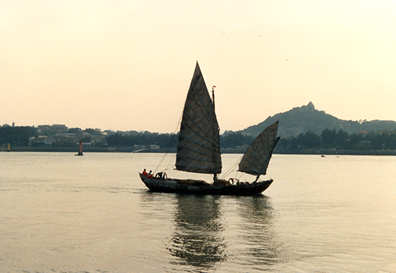
|
|
|
|


